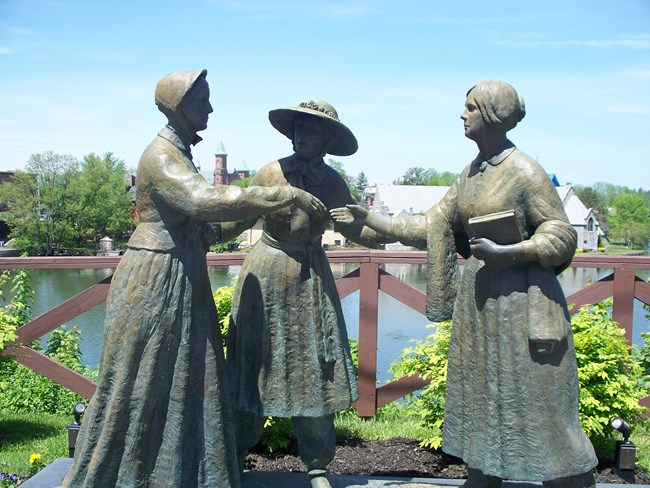 In May 1851 Amelia Bloomer introduced Susan B. Anthony to Elizabeth Cady Stanton as depicted in the life-sized bronze figures sculpted by Ted Aub. In "When Anthony Met Stanton" as in real-life, Bloomer and Stanton are wearing the "Bloomer Costume" which bloomer publicized in "The Lily."
In May 1851 Amelia Bloomer introduced Susan B. Anthony to Elizabeth Cady Stanton as depicted in the life-sized bronze figures sculpted by Ted Aub. In "When Anthony Met Stanton" as in real-life, Bloomer and Stanton are wearing the "Bloomer Costume" which bloomer publicized in "The Lily."NPS
Amelia Bloomer edited the first newspaper for women, The Lily. It was issued from 1849 until 1853. The newspaper began as a temperance journal. Bloomer felt that as women lecturers were considered unseemly, writing was the best way for women to work for reform. Originally, The Lily was to be for “home distribution” among members of the Seneca Falls Ladies Temperance Society, which had formed in 1848. Like most local endeavors, the paper encountered several obstacles early on, and the Society’s enthusiasm died out. Bloomer felt a commitment to publish and assumed full responsibility for editing and publishing the paper. Originally, the title page had the legend “Published by a committee of ladies.” But after 1850 – only Bloomer’s name appeared on the masthead.
Although women’s exclusion from membership in temperance societies and other reform activities was the main force that moved the Ladies Temperance Society to publish The Lily, it was not at first a radical paper. Its editorial stance conformed to the emerging stereotype of women as “defenders of the home.” In the first issue, Bloomer wrote:
It is woman that speaks through The Lily…Intemperance is the great foe to her peace and happiness. It is that above all that has made her Home desolate and beggared her offspring…. Surely, she has the right to wield her pen for its Suppression. Surely, she may without throwing aside the modest refinements which so much become her sex, use her influence to lead her fellow mortals from the destroyer’s path.
The Lily always maintained its focus on temperance. Fillers often told horror stories about the effects of alcohol. For example, the May 1849 issue noted, “A man when drunk fell into a kettle of boiling brine at Liverpool, Onondaga Co. and was scaled to death.” But gradually, the newspaper began to include articles about other subjects of interest to women. Many were from the pen of Elizabeth Cady Stanton, writing under the pseudonym “sunflower.” The earliest Stanton’s articles dealt with the temperance, child-bearing, and education, but she soon turned to the issue of women’s rights. She wrote about laws unfair to women and demanded change.
Bloomer was greatly influenced by Stanton and gradually became a convert to the cause of women’s rights. Recalling the case of an elderly friend who was turned out of her home when her husband died without a will she wrote:
Later, other similar cases coming to my knowledge made me familiar with cruelty of the laws towards women; and when the women rights convention put forth its Declaration of Sentiments. I was ready to join with that party in demanding for women such change in laws as would give her a right to her earnings, and her children a right to wider fields of employment and a better education, and also a right to protect her interest at the ballot box.
Bloomer became interested in dress reform, advocating that women wear the outfit that came to be known as the “Bloomer costume.” Stanton and others copied a knee-length dress with pants worn by Elizabeth Smith Miller of Geneva, New York. Although Bloomer refused to take credit for inventing the pants-and-tunic outfit, her name became associated with it because she wrote articles about the unusual dress, printed illustrations in The Lily, and wore the costume herself. In reference to her advocacy of the costume, she once wrote, “I stood amazed at the furor I had unwittingly caused.” But people certainly were interested in the new fashion. She remembered: “As soon as it became known that I was wearing the new dress, letters came pouring in upon me by the hundreds from women all over the country making inquiries about the dress and asking for patterns – showing how ready and anxious women were to throw off the burden of long, heavy skirts.”
In May of 1851 Amelia Bloomer introduced Susan B. Anthony to Elizabeth Cady Stanton. Stanton said, "I liked her immediately and why I did not invite her home to dinner with me I do not know."
The circulation of The Lily rose from 500 per month to 4000 per month because of the dress reform controversy. At the end of 1853, the Bloomers moved to Mount Vernon, Ohio, where Amelia Bloomer continued to edit The Lily, which by then had a national circulation of over 6000. Bloomer sold The Lily in 1854 to Mary Birdsall, because she and her husband Dexter were moving again this time to Council Bluffs, Iowa, where no facilities for publishing the paper were available. She remained a contributing editor for the two years The Lily survived after she sold it.





















